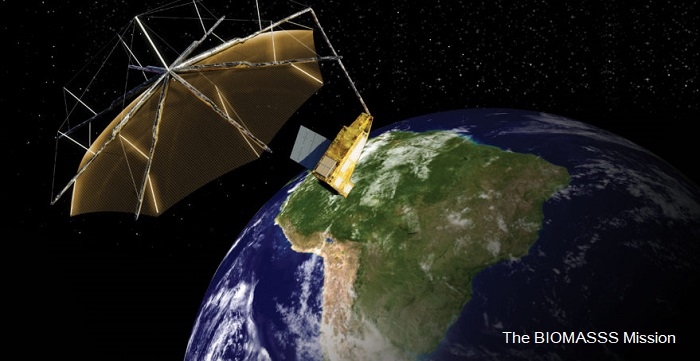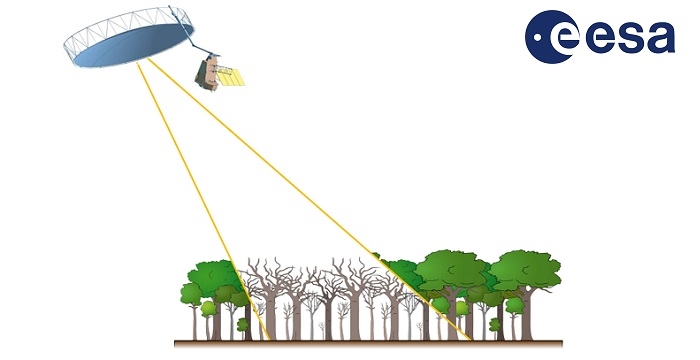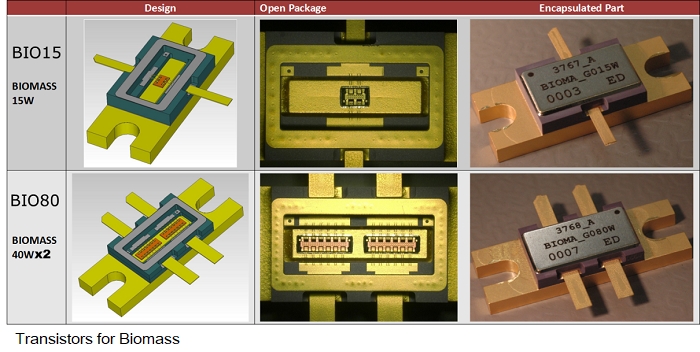
The European Space Agency’s (ESA) upcoming global-surveying mission to survey the Earth’s forest cover, Biomass Earth Explorer, is set to launch by 2022. Under the 5-year mission, the Biomass Earth Explorer satellite, with its 12-m diameter radar antenna will pierce through woodland canopies to perform a global survey of Earth’s forests – and see how they change over the course and also chart the amount of biomass and carbon stored in these forests.
Trees are an integral, much-loved element of the environment; they also hold clues to the collective future. Knowing the amount of carbon bound up in forest biomass will sharpen the understanding of climate change and its likely effects on the global carbon cycle.
The Biomass mission will achieve this using a ‘synthetic aperture radar’ to send down signals from orbit and record the resulting backscatter, building up maps of tree height and volume. To see through leafy treetop to the trees themselves, Biomass will employ long-wavelength ‘P-band’ radar, which has never previously flown in space. It will have its signals amplified to travel down from a 600-km altitude orbit down to Earth and back. The long-wavelength P-band synthetic aperture radar (SAR) will send down signals from orbit and record the resulting backscatter, to build up maps of tree height and volume, and sharpen estimates of global carbon stocks.
In order for the signals to travel down to Earth and back, with a starting point at an altitude of 600 km above the Earth, they’ll have to be amplified. According to Biomass Payload Manager Florence Hélière, traditional amplifiers would be too cumbersome for a satellite using P-band radar. So, the team turned to GaN-based solid-state transistors for their amplifier needs. ESA’s Directorate of Technology, Engineering and Quality worked with the Biomass mission team on the advanced signal amplifiers needed to make the mission feasible, based on the most promising semiconductor since silicon.

These alternative transistors are based on gallium nitride (GaN), hailed as the most promising semiconductor since silicon. Versatile GaN’s ‘wide bandgap’ nature means it has the potential to provide 10 times more radio frequency output power than traditional semiconductors, while also operating at much higher temperatures. As a plus for space, it is also inherently radiation resistant, so can cope with the space environment including unpredictable space weather caused by the Sun.
More than a decade ago, ESA saw the potential of GaN technology, and the importance of developing a reliable supply chain for space use. The result, in 2008, was the GaN Reliability and Technology Transfer initiative – GREAT2, working with European research institutes and industry to manufacture and test space compatible GaN microwave transistors and integrated circuits. The first GaN product flew aboard ESA’s Proba-V mission in 2013.
That early flight-demonstration showed the Biomass team that gallium nitride was ready for them to take up. Then, in 2014, the hard work began. The three-year programme that followed was the most extreme set of quality control processes imaginable. The work was undertaken for ESA by United Monolithic Semiconductors, responsible for the transistor technology, and Tesat-Spacecom, overseeing their assembly, packaging and space qualification, with Airbus Defence and Space overseeing the overall Biomass mission.
To begin with, the GaN wafer batches themselves underwent radio frequency and electrical testing, and were subjected to temperature extremes and squashed or pulled apart. As a next step, functional circuit samples were subjected to accelerated lifetime testing, running for more than 3000 hours with no RF power output degradation to pass ‘lot acceptance testing.’ To safeguard them from the extremes of the orbital environment, the transistors needed to be fully laser-soldered within hermetic packages, followed by various tests to ensure a solid seal, ranging from X-ray inspection to hitting them and detecting the level of echo.

Once fully packaged, parts were tested at random from both the 15 W and 80 W qualification runs for a variety of trials such as vibration and other mechanical testing, microscopic inspection, endurance tests or signal output shape and character. The devices have also completed radiation testing – simulating the interaction with charged particles encountered in space – as well as for various destructive effects known to be triggered by operating high-power radio systems in vacuum.
As a result, these GaN transistors are now fully cleared for integration into the final Biomass radar instrument design. Providing the right technology at the right time for the crucial Earth-observing mission and being also available for other ESA and European missions in the future.